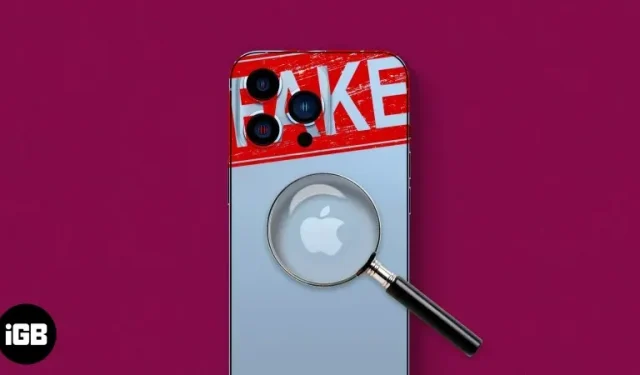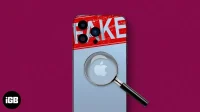The iPhone has become one of the most popular and sought-after smartphones around the world due to its advanced features and stylish design. However, with the emergence of counterfeit products on the market, it is becoming increasingly difficult to distinguish a real iPhone from a fake one. Here I will tell you about different methods and tricks on how to check if iPhone is original or not.
1. Confirm the IMEI number
The IMEI number is the easiest way to verify the authenticity of an iPhone without opening the box. IMEI stands for International Mobile Equipment Identifier. It serves as a unique hardware identifier for your iPhone.
- First, find the phone’s IMEI number on the product box.
- Then go to https://checkcoverage.apple.com/ in any browser.
- In the Serial number field, enter the found IMEI number.
- Then add a captcha → click “Submit”.
- You should be able to see the details of the phone. If the information is missing, the phone is fake.
Double-check the IMEI number on the box and in the Settings app.
Also, the IMEI number can refer to any old iPhone, so check it against the IMEI number found on the device.
- Go to “Settings”→ “General”→ “About”.
- Scroll down to get the IMEI number.
- If the IMEI numbers on the box and in the Settings app don’t match, there’s a good chance your iPhone is fake (unless the device was sold with the wrong box).
Also, the IMEI number is available on the SIM card tray of iPhone except iPhone 14 series. Alternatively, you can dial *#06# to find out your IMEI.
2. Check the model number and serial number.
After IMEI, confirm the serial number and model number of your iPhone. There are several ways to find out the serial number of your iPhone. To get started, copy it and check it on the aforementioned official Apple website. If you see a green checkmark next to Valid Purchase, it means the phone is genuine.
Also, you can find out if the iPhone is new or refurbished. To do this, check the first letter of your iPhone model number in Settings → General → About.
- M: The iPhone is new and original.
- F: The device has been repaired and has been previously used.
- N: The current iPhone has been replaced by a broken iPhone due to a service request.
- P: Apple made a personalized engraved iPhone.
So, now you can find out if someone is trying to sell you a refurbished phone under the name of a new one.
3. Walk through the exterior
Some unique physical elements make the iPhone special.
- You should see a sleep/wake button, a mute switch, and volume controls on the sides of the device.
- Also, your iPhone must have an Apple logo on the back.
- Since iPhones don’t have USB Type-C ports like Android phones, check for a lightning connector at the bottom.
- Also, look for Pentalobe screws near the port to check if the iPhone is real.
- Finally, pay attention to the camera module, bezels and notch. The appearance must match the images on the official Apple website.
- In addition, most iPhone models are made of metal and glass for a superior feel in the hand.
Counterfeit iPhones often have a weaker design and a slightly different design than the original versions. As a result, you should carefully inspect the iPhone from the outside. Your iPhone is probably fake if any of these parts are missing or in an unexpected location.
4. Make sure the internal parts are not modified
Some reports show that customers have been scammed with refurbished iPhones. The device is original, but can be repaired using third-party parts due to some malfunctions. So the iPhone cannot provide the same user experience with the components installed.
To find out if the screen is original or not:
- Enable True Tone on the display.
- Turn on night shift.
- See if you’re getting haptic feedback.
Also, if you have an iPhone 11 or later (running iOS 15.2 or later) and if it has gone through any service replacements, you can see the details here:
- Go to “Settings”→ “General”→ “About”.
- In the “Parts and Service History”section, you will see the name of the part. If Unknown is displayed, the installed part is not owned by Apple or is used in another iPhone.
5. Network connection
All iPhone models can connect to Wi-Fi, EDGE and Bluetooth. In addition, Apple Pay is supported via NFC and file sharing via AirDrop. So if you buy an iPhone that can’t connect to one of these networks, chances are it’s a fake.
6. Sync your new iPhone with Quick Start
To check whether the iPhone is real or fake, you can try connecting to iTunes and see if iTunes recognizes your iPhone. If the phone can’t install an iOS backup from iCloud or sync data to your Mac, it’s not the original.
Also, bring your old iPhone close to your new iPhone for setup. If you can’t use Quick Start to set up, the latter is fake.
7. Confirm iOS
iOS on the iPhone is markedly different from Android in terms of look, feel, and performance. So, fake iPhones are trying to copy the interface.
Also, when you set up your new iPhone, it asks you to create an Apple ID. If it prompts you to sign in with your Google account or something, the iPhone is not real.
8. Look for system apps
The iPhone comes with a different App Store for iOS apps only. So, you can try to open it. If you see the Google Play Store, the iPhone is not original. In addition, Apple includes certain system apps such as Safari, Health, Music, Compass, Calculator, etc. that cannot be uninstalled. Therefore, if any of these are missing, the phone is either hacked or fake.
You can restore the original firmware by going into DFU mode and reinstalling the operating system. Your iPhone is probably fake if the native apps are still missing.
9. Activate Siri
Siri is an entirely internal Apple technology. So counterfeit iPhone makers can’t include Siri on their phones and use Google Assistant, Amazon Alexa, or other voice assistants instead. Instead, try activating Siri by long pressing the power button. If it doesn’t pop up, the iPhone isn’t real.
10. Get verified at an Apple Store or service provider.
If you still think it’s fake, you can take your iPhone to the nearest Apple Store or Apple Authorized Service Provider. Your iPhone may undergo diagnostic tests conducted by a retailer to check your Apple iPhone.
Beware of iPhone scams!
Buying a fake iPhone can lead to loss of money and frustration. Thus, you should check your Apple iPhone before purchasing to make an informed purchase and avoid being scammed. Whether you just bought an iPhone or plan to buy one, I hope this guide will provide you with the information you need to check if the iPhone is original.


